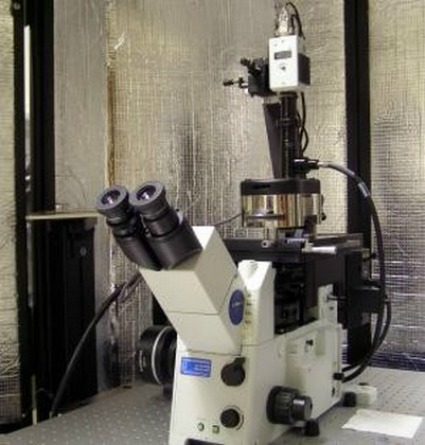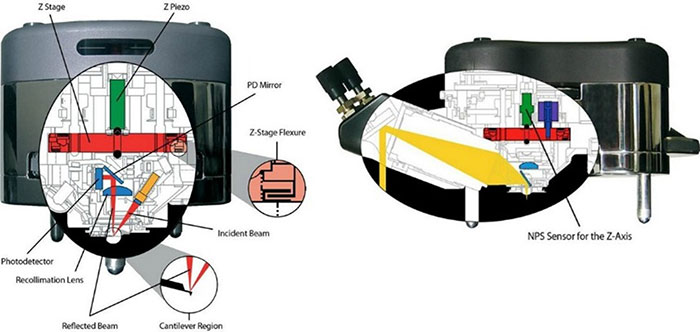Overview:
An Atomic Force Microscope (AFM) is a very high-resolution type of Scanning Probe Microscope, AFM, also referred to as SPM or Scanning Probe Microscopy, is a high-resolution imaging technique that can resolve features as small as an atomic lattice in the real space. It allows researchers to observe and manipulate at the molecular and atomic level.
Current model:


See video for further information
The MFP-3D BIO is a high-performance Atomic Force Microscope (AFM) designed specifically for biological applications. It is a versatile AFM that combines molecular resolution imaging and pN force-based measurements on an inverted optical microscope. Combined with its ultra-low noise performance and unprecedented precision and accuracy, the MFP-3D-BIO has raised the bar for AFM instrumentation in bioscience
Main Features:
- Scanning Tip design
- Atomic Resolution
- Liquid immersion capability
- Nanoindentation capability on soft materials
- Nanolithography capability
- Conductive AFM
- Active Vibration isolation
- Environmental chamber
Technical Specifications:
AFM Head and Scanner
Operating modes
Contact mode, Acoustic A/C and phase imaging modes.
AFM in liquid: Contact, Acoustic A/C, Lateral Force Microscopy (LFM), Phase imaging mode, Force modulation mode, Adhesion force imaging and chemical force microscopy (CFM).
Other modes available include Magnetic Force microscopy (MFM), Conductive AFM and Electric force microscopy.
MicroAngeloTM nanolithography
Sample size
System supports samples dimensions up to 100mm x 100mm x 20mm (X x Y x Z).
XYZ Scan range
Scan range up to 90 µm x 90 µm x 7 µm (Noise level XY< 6Å, Z <3Å Adev).
They have independent x, -x, y, -y, z piezos for accurate, linearised flat scanning.
Optical Microscope & camera:
- Video Access or tip/sample area with colour CCD camera, zoom 2.1 to 13.5x, resolution better than 2 microns, field of view approximately 1.3 mm x 1mm x 0.2 mm x 0.15mm.
- The Top View module uses a Plan APO 10x/NA 0.28 objective integrated in the scan head and enables viewing of opaque samples, and easy alignment of the beam on the cantilever. The phase contrast illumination module utilizes the same objective for use as a condenser lens.
- Inverted optical microscope AFM flexibly combines with many optical techniques such as bright field, phase, epifluorescence, confocal, TIRF, FRET, etc.
AFM software:
- User-friendly interface built on IGOR Pro integrates analysis, scripting and publication-quality graphics.
- Built-in, easy cantilever calibration by the thermal or Sader methods.
- Measure force curves at specified locations on your sample with a simple click of the mouse.
- Process images using auto-generated masks to eliminate artifacts.
- Add fit equations to section plots, histograms or any other data set.
- ARgyleT software module (which comes standard), allows users to render images in advanced 3D mode, as stereo anaglyphs (3D glasses), or as overlays by combining separate channels of data into a single 3D image (ie. confocal data as colour scale on a 3D AFM topography image).
- System includes computer with competitive specifications and dual-monitor 3D graphics card.
Other features:
- BioHeater heats samples to 80°C with an accuracy of 0.1°C
- Closed fluid cell with 10 ports allows imaging in a completely sealed environment.
- PolyHeater (non-liquid samples only) heats samples to 300°C with an accuracy of 0.3°C.
Typical samples:
AFM can be used on a very wide variety of surfaces such as carbon nanotubes, thin films, coatings, graphene, metals, ceramics, particles, or biological samples etc.
Standards:
Samples can be accessed in accordance with other standards: ASTM E2859 – 11(2017), ISO 18115 – 2, ISO 11775:2015, ISO 13095:2014, and ISO 21222:2020.
